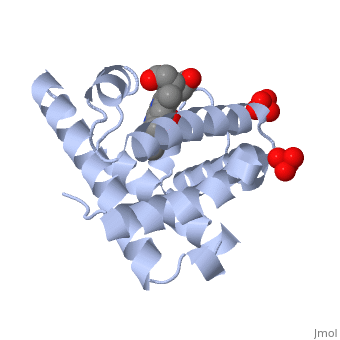Myoglobin
From Proteopedia
FunctionMyoglobin is a protein found in muscle tissues that plays a critical role in the storage and transport of oxygen. It is structurally and functionally related to hemoglobin, the protein responsible for oxygen transport in red blood cells. While hemoglobin carries oxygen throughout the body, myoglobin is primarily found in muscle cells and facilitates the uptake and release of oxygen within the muscles themselves. Structural highlightsMyoglobin is a globular protein whose function is to store molecular oxygen in muscles (myo = muscles)[1]. It has two main components: a single polypeptide chain, and heme ligand. The heme ligand is only to the surface; the majority of it is buried inside the protein. The overall of myoglobin is approximately disc-shaped with a diameter that is about twice its thickness. The overall fold of the protein is conserved, especially the core of the protein (shown in purple), but the sequence is more on the surface. The , and specifically the iron atom in the middle of the heme, is what binds oxygen in myoglobin. In this representation, the heme alone is shown in ball and stick form with its C, N and O atoms displayed as grey, blue, and red balls respectively. The iron atom is shown in orange, and is in spacefilling mode to better illustrate its interactions with the heme. The iron is bound by four nitrogen atoms found in the heme ring, as well as an from the protein chain. Which amino acid from the myoglobin protein binds to the iron? Notice that in the oxygenated state, the iron is in the plane of the heme ring. In the (no oxygen) state, the Fe atom is slightly above the plane of the heme, and a second coordinates with the iron in the heme ring. FunctionThe main function of myoglobin is to store oxygen in muscle tissues and provide a readily available supply during periods of increased demand, such as during muscle contraction or exercise. When the muscle cells have an ample supply of oxygen, myoglobin binds to oxygen molecules, effectively storing them within the muscle fibers. During periods of oxygen deficiency, such as during intense exercise when oxygen demand exceeds supply, myoglobin releases the stored oxygen to the surrounding muscle cells. This ensures that the muscle cells have a sufficient oxygen supply to support their metabolic needs, facilitating aerobic respiration and energy production. The affinity of myoglobin for oxygen is higher than that of hemoglobin, which allows myoglobin to extract oxygen from hemoglobin in the bloodstream when oxygen levels are low. This property enables efficient oxygen transfer from the bloodstream to the muscle tissues. The red color of muscle tissues is attributed to the presence of myoglobin, as it binds oxygen, giving the oxygenated muscle a characteristic reddish appearance. Myoglobin is also used as a diagnostic marker for certain medical conditions. For example, elevated levels of myoglobin in the blood can indicate muscle damage or injury, such as in cases of heart attacks or skeletal muscle trauma. In summary, myoglobin is a protein found in muscle tissues that functions as an oxygen reservoir, allowing the efficient storage and release of oxygen within muscle cells. Its ability to bind and release oxygen helps sustain aerobic respiration in muscles during times of increased demand, such as during exercise. Additional detailsOxymyoglobin for myoglobin complex with O2
Myoglobin-Physeter-catodon-structure (Spanish) 3D Structures of Myoglobin
| ||||||||||||
External Resources
References
- ↑ Ordway GA, Garry DJ. Myoglobin: an essential hemoprotein in striated muscle. J Exp Biol. 2004 Sep;207(Pt 20):3441-6. PMID:15339940 doi:http://dx.doi.org/10.1242/jeb.01172
Proteopedia Page Contributors and Editors (what is this?)
Michal Harel, Ann Taylor, Alexander Berchansky, Joel L. Sussman, Eric Martz, Jaime Prilusky, Karsten Theis, Karl Oberholser, Eran Hodis, Judy Voet, David Canner


